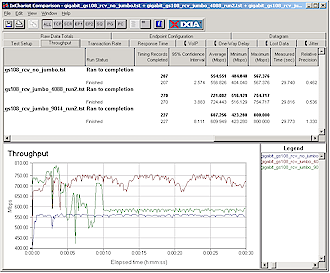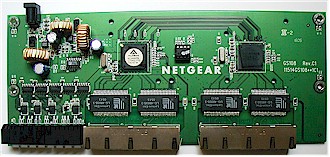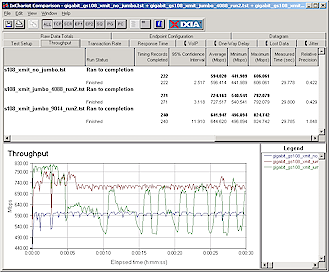The Pitch & Product

| NETGEAR ProSafe 8 Port Gigabit Desktop Switch (GS108) | |
|---|---|
| Summary | 8 port gigabit switch with up to 9K Jumbo Frame support. Jumbo frames supported on product available after Sept 2005. Check product box carefully! |
| Update | 8/6/2005 – Added info about SMC8508T |
| Pros | • Gigabit Ethernet with Jumbo Frame support for not a lot of $ |
| Cons | • Hard to tell if you’re buying Jumbo Frame capable product |
As gigabit Ethernet continues its inexorable march into SOHO networks, prices are dropping and “10/100/1000” is seen more frequently on product front panels and retail boxes where “10/100” once appeared. But it’s still not very easy to find a 4 to 16 port gigabit switch or other SOHO gigabit products other than Ethernet adapters with jumbo frame capability.
Jumbo frames are simply Ethernet frames (packets) larger than 1500 Bytes. If your computer and OS are up to it, their use can boost networking throughput significantly.
TIP: If you’d like additional background on jumbo frames try this article.
Until now, ASUS has been the only manufacturer to support jumbo frame capability in a SOHO-oriented product, namely its RX3141, which I looked at a few months ago. So when NETGEAR recently told me that it was updating its GS108 8 port gigabit switch to support jumbo frames, I asked them to send one over so that I could check it out. An engineering sample arrived in short order that, aside from being labeled “engineering sample” and not coming in a retail box, was the same as what they’ll be shipping.
Update 8/6/2005 – A reader pointed out that SMC’s SMC8508T also supports up to 9K jumbo frames at a similar price point to the GS108 and has been available for some time.
Figure 1 shows the GS108 uses an Altima (acquired by Broadcom in 2000) AC388 switch chip and Broadcom BCM 5014 quad PHY. This combo is used instead of the Broadcom BCM5385 5 port switch chip used in the RX3141, as well as D-Link’s DGL-4100 and DGL-4300 [reviewed here] gaming routers, and 5 port gigabit switches from Belkin, Linksys, TRENDnet and others.
Figure 1: GS108 board
(click image to enlarge)
With this chipset, jumbo frame support can be programmed to be on or off. But it’s a factory-programmed option – probably via the Atmel 93C46 EEPROM shown in Figure 1 located between the other two chips. So this means that existing GS108’s can’t be field-upgraded.
Since the GS108 is a plain ol’ unmanaged switch, there’s nothing you need (or can) do to it to use jumbo frames. All you need to do is have a gigabit Ethernet NIC that supports jumbo frames and enable the feature there. Note, however, that once you enable jumbo frames, everything that computer communicates with on your LAN also must support jumbo frames. In addition, everything needs to be set to use the same size jumbo frame.
You’ll know right away if you try to use a jumbo frame-enabled PC with non-jumbo frame gear. For example, everything worked fine when I network-browsed over to another jumbo frame-enabled PC. But when I tried to web browse, I got very slow page loads and sometimes none at all. This was because my router’s 10/100 Ethernet switch that I had the GS108 uplinked to couldn’t properly deal with the jumbo-sized data packets I was sending.
The Test and Verdict
Since the GS108 is an unmanaged switch, there’s not much more to say about it, so I’ll cut right to the testing.
I tested using two systems running WinXP SP2 – one an Athlon 64 3000+ w/ 512 MB, the other a 2.4GHz Pentium 4 w/ 504MB. I ran the IxChariot high performance_throughput script with no changes using TCP/IP. This script sends 10,000,000 Bytes between test endpoints and instructs endpoints running on Windows NT, 2000, and XP to use overlapped I/O to achieve the highest possible throughput.
Each machine had an Intel Pro 1000/MT desktop adapter with 8.5.14.0 (3/8/2005) driver. The adapters were both set to “Auto Detect” mode and reported connecting at 1000Mbps Full Duplex. The adapters allow setting jumbo frame sizes of 4088, 9014 and 16128 Bytes. But since the GS108 jumbo frame feature supports only up to 9K frame sizes, I limited my testing to the 4088 and 9014 settings.
Figure 2: GS108 xmit throughput comparison
(click on the image for a larger view)
Figures 2 and 3 show results similar to those I found when testing the RX3141’s jumbo frame feature. For my setup, best results were achieved using the 4088 Byte (4K) setting. I got a 22% improvement in average transmit throughput and just shy of 30% for receive.

Figure 3: GS108 rcv throughput comparison
(click on the image for a larger view)
You can see that while using 9K (9014) jumbo frames provided a net increase in average throughput over the 30 second test, throughput was highly variable. This fallback in throughput with larger jumbo frame size is not due to anything in the GS108, but to hardware and software limitations in the two computers used for the test.
So contrary to what a few networking product manufacturers have told me, jumbo frames can improve performance for non-enterprise networking users and – at least the way the GS108 implements it – the feature is a no-brainer to use.The tricky part for consumers, at least during the period while retail inventories are changing over, will be figuring out whether you’re buying a GS108 that supports jumbo frames.
NETGEAR doesn’t plan to change the GS108’s model number and told me purchasers will be able to identify the jumbo frame version by the specifications printed on the box. Another method will be via serial number, after NETGEAR publishes information that describes which serial numbers are which. Unfortunately, both methods require physical inspection of the product, which doesn’t work for corporate or e-tail buyers. NETGEAR also said that while they expect to roll the jumbo frame change into production during August, it could be late September before product hits shelves.
So kudos for NETGEAR for leading the way on jumbo frames for the masses, and doing it with no price increase! But I hope they relent and make it possible for buyers to know that they’re getting jumbo frame-capable product without actually having product in-hand.


